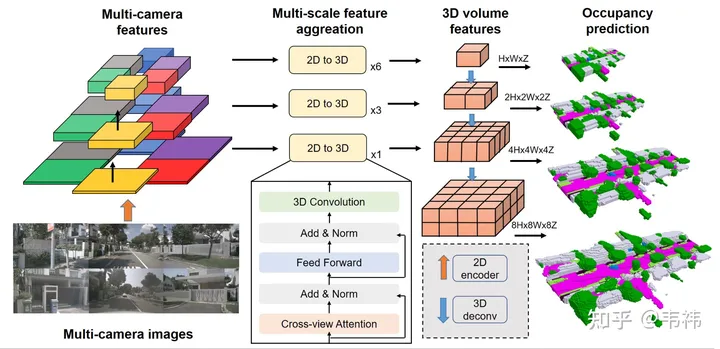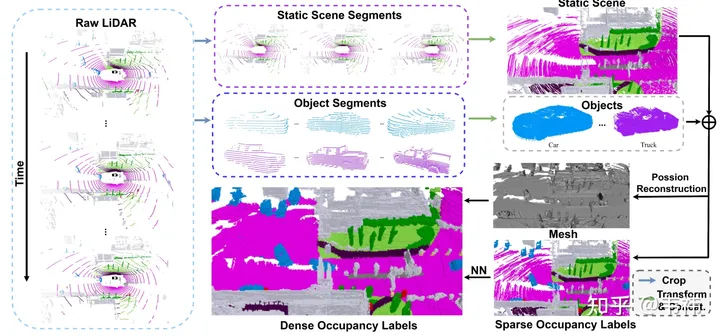SurroundOcc: Surround 3D occupancy grid new SOTA!
In this work, we constructed a dense occupancy raster dataset through multi-frame point clouds and designed a three-dimensional occupancy raster network based on the transformer's 2D-3D Unet structure. We are honored that our article has been included in ICCV 2023. The project code is now open source and everyone is welcome to try it.

arXiv: https://arxiv.org/pdf/2303.09551.pdf
Code: https://github.com/weiyithu/SurroundOcc
Homepage link: https://weiyithu.github.io/SurroundOcc/
I have been looking for a job like crazy recently and have no time to write. I just recently submitted camera-ready as a working person. In the end, I thought it would be better to write a Zhihu summary. In fact, the introduction of the article is already well written by various public accounts, and thanks to their publicity, you can directly refer to the Heart of Autonomous Driving: nuScenes SOTA! SurroundOcc: Pure visual 3D occupancy prediction network for autonomous driving (Tsinghua & Tianda). In general, the contribution is divided into two parts. One part is how to use multi-frame lidar point clouds to build a dense occupancy data set, and the other part is how to design a network for occupancy prediction. In fact, the contents of both parts are relatively straightforward and easy to understand. If you don’t understand anything, you can always ask me. So in this article, I want to talk about something other than the thesis. One is how to improve the current solution to make it easier to deploy, and the other is the future development direction.

Deployment

Whether a network is easy to deploy mainly depends on whether it is difficult to deploy. Operators implemented on the board end, the two more difficult operators in the SurroundOcc method are the transformer layer and 3D convolution.
The main function of the transformer is to convert 2D features into 3D space. In fact, this part can also be implemented using LSS, Homography or even mlp, so this part of the network can be modified according to the implemented solution. But as far as I know, the transformer solution is not sensitive to calibration and has better performance among several solutions. It is recommended that those who have the ability to implement transformer deployment should use the original solution.
For 3D convolution, you can replace it with 2D convolution. Here you need to reshape the original 3D feature of (C, H, W, Z) into (C* Z, H, W) 2D feature, then you can use 2D convolution for feature extraction. In the final occupancy prediction step, it is reshaped back to (C, H, W, Z) and supervised. On the other hand, skip connection consumes more video memory due to its larger resolution. During deployment, it can be removed and only the minimum resolution layer will be left. Our experiments found that these two operations in 3D convolution will have some drop points on nuscenes, but the scale of the industry's data set is much larger than nuscenes. Sometimes some conclusions will change, and the drop points should be less or even none.

In terms of dataset construction, the most time-consuming step is Poisson reconstruction. We use the nuscenes data set, which uses 32-line lidar for collection. Even when using multi-frame stitching technology, we found that there are still many holes in the stitched point cloud. Therefore, we employed Poisson reconstruction to fill these holes. However, many lidar point clouds currently used in the industry are relatively dense, such as M1, RS128, etc. Therefore, in this case, the Poisson reconstruction step can be omitted to speed up the construction of the data set
On the other hand, SurroundOcc uses the three-dimensional target detection frame marked in nuscenes to combine the static scene and Dynamic objects are separated. However, in actual application, autolabel, which is a large three-dimensional target detection & tracking model, can be used to obtain the detection frame of each object in the entire sequence. Compared with manually annotated labels, the results produced by using large models will definitely have some errors. The most direct manifestation is the phenomenon of ghosting after splicing multiple frames of objects. But in fact, occupation does not have such high requirements for the shape of objects. As long as the position of the detection frame is relatively accurate, it can meet the requirements.
Future Direction
The current method still relies on lidar to provide occupancy supervision signals, but many cars, especially some low-level assisted driving cars, do not have lidar. These cars A large amount of RGB data can be returned through shadow mode, so a future direction is whether we can only use RGB for self-supervised learning. A natural solution is to use NeRF for supervision. Specifically, the front backbone part remains unchanged to obtain an occupancy prediction, and then voxel rendering is used to obtain the RGB from each camera perspective, and the loss is done with the true value RGB in the training set. Create a supervisory signal. But it is a pity that this straightforward method did not work very well when we tried it. The possible reason is that the range of the outdoor scene is too large, and the nerf may not be able to hold it, but it is also possible that we have not adjusted it properly. You can try it again. .
The other direction is timing & occupation flow. In fact, occupation flow is far more useful for downstream tasks than single-frame occupation. During ICCV, we didn’t have time to compile the data set of occupation flow, and when we published the paper, we had to compare many flow baselines, so we didn’t work on it at that time. For timing networks, you can refer to the solutions of BEVFormer and BEVDet4D, which are relatively simple and effective. The difficult part is still the flow data set. General objects can be calculated using the three-dimensional target detection frame of sequence, but special-shaped objects such as small animal plastic bags may need to be annotated using the scene flow method.

The content that needs to be rewritten is: Original link: https://mp.weixin.qq.com/s/_crun60B_lOz6_maR0Wyug
The above is the detailed content of SurroundOcc: Surround 3D occupancy grid new SOTA!. For more information, please follow other related articles on the PHP Chinese website!

Hot AI Tools

Undresser.AI Undress
AI-powered app for creating realistic nude photos

AI Clothes Remover
Online AI tool for removing clothes from photos.

Undress AI Tool
Undress images for free

Clothoff.io
AI clothes remover

AI Hentai Generator
Generate AI Hentai for free.

Hot Article

Hot Tools

Notepad++7.3.1
Easy-to-use and free code editor

SublimeText3 Chinese version
Chinese version, very easy to use

Zend Studio 13.0.1
Powerful PHP integrated development environment

Dreamweaver CS6
Visual web development tools

SublimeText3 Mac version
God-level code editing software (SublimeText3)

Hot Topics
 1378
1378
 52
52
 Why is Gaussian Splatting so popular in autonomous driving that NeRF is starting to be abandoned?
Jan 17, 2024 pm 02:57 PM
Why is Gaussian Splatting so popular in autonomous driving that NeRF is starting to be abandoned?
Jan 17, 2024 pm 02:57 PM
Written above & the author’s personal understanding Three-dimensional Gaussiansplatting (3DGS) is a transformative technology that has emerged in the fields of explicit radiation fields and computer graphics in recent years. This innovative method is characterized by the use of millions of 3D Gaussians, which is very different from the neural radiation field (NeRF) method, which mainly uses an implicit coordinate-based model to map spatial coordinates to pixel values. With its explicit scene representation and differentiable rendering algorithms, 3DGS not only guarantees real-time rendering capabilities, but also introduces an unprecedented level of control and scene editing. This positions 3DGS as a potential game-changer for next-generation 3D reconstruction and representation. To this end, we provide a systematic overview of the latest developments and concerns in the field of 3DGS for the first time.
 How to solve the long tail problem in autonomous driving scenarios?
Jun 02, 2024 pm 02:44 PM
How to solve the long tail problem in autonomous driving scenarios?
Jun 02, 2024 pm 02:44 PM
Yesterday during the interview, I was asked whether I had done any long-tail related questions, so I thought I would give a brief summary. The long-tail problem of autonomous driving refers to edge cases in autonomous vehicles, that is, possible scenarios with a low probability of occurrence. The perceived long-tail problem is one of the main reasons currently limiting the operational design domain of single-vehicle intelligent autonomous vehicles. The underlying architecture and most technical issues of autonomous driving have been solved, and the remaining 5% of long-tail problems have gradually become the key to restricting the development of autonomous driving. These problems include a variety of fragmented scenarios, extreme situations, and unpredictable human behavior. The "long tail" of edge scenarios in autonomous driving refers to edge cases in autonomous vehicles (AVs). Edge cases are possible scenarios with a low probability of occurrence. these rare events
 Choose camera or lidar? A recent review on achieving robust 3D object detection
Jan 26, 2024 am 11:18 AM
Choose camera or lidar? A recent review on achieving robust 3D object detection
Jan 26, 2024 am 11:18 AM
0.Written in front&& Personal understanding that autonomous driving systems rely on advanced perception, decision-making and control technologies, by using various sensors (such as cameras, lidar, radar, etc.) to perceive the surrounding environment, and using algorithms and models for real-time analysis and decision-making. This enables vehicles to recognize road signs, detect and track other vehicles, predict pedestrian behavior, etc., thereby safely operating and adapting to complex traffic environments. This technology is currently attracting widespread attention and is considered an important development area in the future of transportation. one. But what makes autonomous driving difficult is figuring out how to make the car understand what's going on around it. This requires that the three-dimensional object detection algorithm in the autonomous driving system can accurately perceive and describe objects in the surrounding environment, including their locations,
 The Stable Diffusion 3 paper is finally released, and the architectural details are revealed. Will it help to reproduce Sora?
Mar 06, 2024 pm 05:34 PM
The Stable Diffusion 3 paper is finally released, and the architectural details are revealed. Will it help to reproduce Sora?
Mar 06, 2024 pm 05:34 PM
StableDiffusion3’s paper is finally here! This model was released two weeks ago and uses the same DiT (DiffusionTransformer) architecture as Sora. It caused quite a stir once it was released. Compared with the previous version, the quality of the images generated by StableDiffusion3 has been significantly improved. It now supports multi-theme prompts, and the text writing effect has also been improved, and garbled characters no longer appear. StabilityAI pointed out that StableDiffusion3 is a series of models with parameter sizes ranging from 800M to 8B. This parameter range means that the model can be run directly on many portable devices, significantly reducing the use of AI
 This article is enough for you to read about autonomous driving and trajectory prediction!
Feb 28, 2024 pm 07:20 PM
This article is enough for you to read about autonomous driving and trajectory prediction!
Feb 28, 2024 pm 07:20 PM
Trajectory prediction plays an important role in autonomous driving. Autonomous driving trajectory prediction refers to predicting the future driving trajectory of the vehicle by analyzing various data during the vehicle's driving process. As the core module of autonomous driving, the quality of trajectory prediction is crucial to downstream planning control. The trajectory prediction task has a rich technology stack and requires familiarity with autonomous driving dynamic/static perception, high-precision maps, lane lines, neural network architecture (CNN&GNN&Transformer) skills, etc. It is very difficult to get started! Many fans hope to get started with trajectory prediction as soon as possible and avoid pitfalls. Today I will take stock of some common problems and introductory learning methods for trajectory prediction! Introductory related knowledge 1. Are the preview papers in order? A: Look at the survey first, p
 SIMPL: A simple and efficient multi-agent motion prediction benchmark for autonomous driving
Feb 20, 2024 am 11:48 AM
SIMPL: A simple and efficient multi-agent motion prediction benchmark for autonomous driving
Feb 20, 2024 am 11:48 AM
Original title: SIMPL: ASimpleandEfficientMulti-agentMotionPredictionBaselineforAutonomousDriving Paper link: https://arxiv.org/pdf/2402.02519.pdf Code link: https://github.com/HKUST-Aerial-Robotics/SIMPL Author unit: Hong Kong University of Science and Technology DJI Paper idea: This paper proposes a simple and efficient motion prediction baseline (SIMPL) for autonomous vehicles. Compared with traditional agent-cent
 nuScenes' latest SOTA | SparseAD: Sparse query helps efficient end-to-end autonomous driving!
Apr 17, 2024 pm 06:22 PM
nuScenes' latest SOTA | SparseAD: Sparse query helps efficient end-to-end autonomous driving!
Apr 17, 2024 pm 06:22 PM
Written in front & starting point The end-to-end paradigm uses a unified framework to achieve multi-tasking in autonomous driving systems. Despite the simplicity and clarity of this paradigm, the performance of end-to-end autonomous driving methods on subtasks still lags far behind single-task methods. At the same time, the dense bird's-eye view (BEV) features widely used in previous end-to-end methods make it difficult to scale to more modalities or tasks. A sparse search-centric end-to-end autonomous driving paradigm (SparseAD) is proposed here, in which sparse search fully represents the entire driving scenario, including space, time, and tasks, without any dense BEV representation. Specifically, a unified sparse architecture is designed for task awareness including detection, tracking, and online mapping. In addition, heavy
 FisheyeDetNet: the first target detection algorithm based on fisheye camera
Apr 26, 2024 am 11:37 AM
FisheyeDetNet: the first target detection algorithm based on fisheye camera
Apr 26, 2024 am 11:37 AM
Target detection is a relatively mature problem in autonomous driving systems, among which pedestrian detection is one of the earliest algorithms to be deployed. Very comprehensive research has been carried out in most papers. However, distance perception using fisheye cameras for surround view is relatively less studied. Due to large radial distortion, standard bounding box representation is difficult to implement in fisheye cameras. To alleviate the above description, we explore extended bounding box, ellipse, and general polygon designs into polar/angular representations and define an instance segmentation mIOU metric to analyze these representations. The proposed model fisheyeDetNet with polygonal shape outperforms other models and simultaneously achieves 49.5% mAP on the Valeo fisheye camera dataset for autonomous driving




